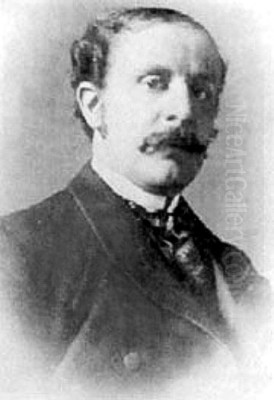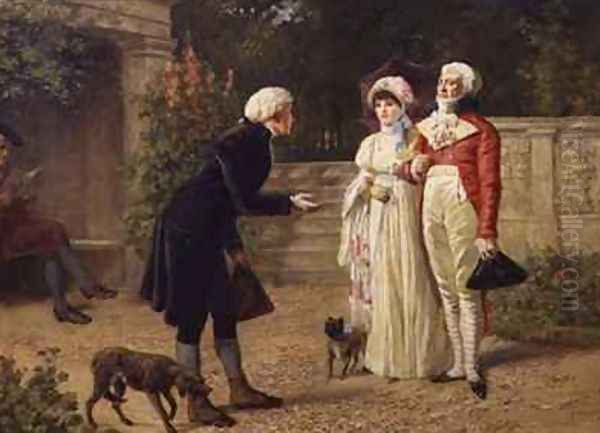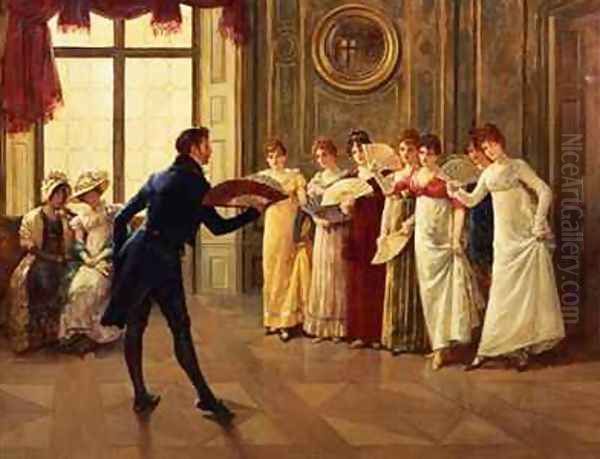
Henry Gillard Glindoni (1852-1913) stands as a notable figure in the landscape of late Victorian art in Britain. A painter celebrated for his meticulous and engaging depictions of historical and costume genre scenes, particularly those set in the 17th and 18th centuries, Glindoni captured the imagination of his contemporaries. His work, frequently exhibited at prestigious London institutions, resonated with the Victorian appetite for narrative, historical detail, and often, a touch of romanticism or gentle humour. His artistic journey, from the theatrical world to the esteemed galleries of the Royal Academy, reveals a dedicated craftsman with a keen eye for a compelling story.
Early Life and Theatrical Foundations
Born in London in 1852, Henry Gillard Glindoni's early life was marked by a formative connection to the world of theatre. Following the early death of his father, he was raised by his grandparents. It was his grandfather, a man with connections to the theatrical scene, who introduced the young Glindoni to this vibrant environment. He began his artistic endeavors by painting scenes for theatrical productions, an experience that would profoundly shape his later easel work. This apprenticeship in the theatre provided him with invaluable skills in composition, the dramatic use of light and shadow, and, crucially, an understanding of costume and period detail.
This practical training in creating convincing illusions on stage translated directly into his paintings. Unlike artists who might have come solely through academic training, Glindoni’s theatrical background instilled in him a sense of stagecraft. His painted scenes often feel like carefully arranged tableaux, with figures positioned to maximize narrative clarity and emotional impact. This early immersion in a world of make-believe and historical reenactment laid a strong foundation for his future specialization. He was not alone in this trajectory; artists like Clarkson Stanfield and David Roberts also transitioned from successful careers as scene painters to become highly respected easel painters in the Royal Academy.
Artistic Development and Dominant Themes

Glindoni's artistic output primarily focused on genre scenes and historical subjects, with a particular fondness for the 17th and 18th centuries. These periods, with their distinctive fashions, social customs, and rich historical narratives, offered fertile ground for his imagination. His paintings are characterized by their intricate detail, especially in the rendering of costumes, furniture, and architectural settings. This meticulousness was a hallmark of much Victorian genre painting, where audiences appreciated the effort taken to recreate the past with apparent authenticity.
His themes often revolved around everyday life, romantic encounters, moments of quiet contemplation, or humorous social interactions. Works frequently depicted scenes of courtship, domestic life, scholarly pursuits, or convivial gatherings. There is a warmth and accessibility to many of his paintings, inviting viewers to step into a bygone era. While some Victorian artists, like William Powell Frith with his sprawling canvases of modern life such as Derby Day or The Railway Station, focused on contemporary society, Glindoni found his niche in evoking the charm and perceived elegance of earlier times.
The narrative element was paramount in Glindoni's art. Each painting tells a story, often with a subtle moral or a gentle observation on human nature. In this, he can be seen as an inheritor of the tradition of British narrative painting, which had strong roots in the work of 18th-century artists like William Hogarth. While Glindoni’s work generally lacked the biting satire of Hogarth’s series like A Rake's Progress or Marriage A-la-Mode, the emphasis on storytelling through carefully observed detail and character interaction is a shared characteristic.
Exhibitions and Professional Recognition
Henry Gillard Glindoni was a prolific exhibitor, and his works were regularly seen at some of London's most important art venues. He frequently showed his paintings at the Royal Academy of Arts, the bastion of the British art establishment. His inclusion in the Royal Academy's annual exhibitions was a significant mark of professional achievement and brought his work to a wide and influential audience. Artists like Frederic Leighton, Lawrence Alma-Tadema, and John Everett Millais were dominant figures at the RA during parts of Glindoni's career, setting high standards for technical skill and popular appeal.
Beyond the Royal Academy, Glindoni also exhibited with the Royal Institute of Oil Painters (ROI), an organization that provided an alternative exhibiting venue for artists working in oils. Furthermore, he was associated with the Royal Watercolour Society (often referred to historically as the Old Watercolour Society or OWS), indicating his proficiency in this medium as well, though he is primarily known for his oil paintings.

A significant milestone in his career was his election as a full member of the Royal Society of British Artists (RBA). The RBA, located on Suffolk Street, was another important exhibiting society, and membership conferred considerable prestige. James McNeill Whistler famously served as its president for a period, attempting to modernize it, though Glindoni's more traditional style would have aligned well with the society's broader membership. Glindoni's consistent presence in these major exhibitions underscores his acceptance within the mainstream art world of his time and the popularity of his chosen subjects.
Signature Style: Detail, Drama, and Victorian Sensibilities
Glindoni's style is characterized by its clarity, polished finish, and attention to detail, all hallmarks of academic painting in the Victorian era. His figures are well-drawn, and their expressions and gestures are carefully calibrated to convey the narrative. He had a particular skill in rendering the textures of fabrics – the sheen of silk, the richness of velvet, the crispness of linen – which brought his historical costumes to life. This focus on material detail was something shared by many contemporaries, including historical painters like Marcus Stone, known for his romantic Regency and 18th-century scenes, or even the more classically inclined Alma-Tadema with his "marbellous" depictions of ancient Rome.
The compositions are often theatrical, with figures arranged in a way that draws the viewer's eye to the central action or emotional core of the scene. Lighting is used effectively to highlight key elements and create mood, a skill likely honed during his time as a scene painter. There is a certain romanticism that pervades his work, even when depicting everyday scenes. This appealed to Victorian sensibilities, which often idealized the past and appreciated art that was both aesthetically pleasing and morally uplifting, or at least, engagingly anecdotal.
His palette was generally rich and harmonious, avoiding the more radical colour experiments of the Impressionists who were emerging during his career. Glindoni remained firmly rooted in the tradition of representational art, focusing on skillful execution and narrative content. His work can be contrasted with the social realism of artists like Luke Fildes or Frank Holl, who often depicted the harsher realities of Victorian life. Glindoni's historical scenes offered an escape, a glimpse into a world perceived as more elegant or picturesque.
Notable Works and Their Stories
Several of Henry Gillard Glindoni's paintings have become particularly well-known, either for their subject matter, their inherent charm, or intriguing backstories.

One of his most famous and fascinating works is _John Dee Performing an Experiment before Elizabeth I_. This painting depicts the renowned 16th-century mathematician, astronomer, astrologer, and occult philosopher John Dee demonstrating a scientific or alchemical experiment to Queen Elizabeth I and her court. The scene is rich in historical detail, from the costumes to the alchemical apparatus. What makes this painting particularly intriguing is a discovery made through modern X-ray analysis: originally, Glindoni had painted a circle of human skulls around Dee, emphasizing the occult and perhaps more controversial aspects of Dee's work. At some point, possibly to make the painting more palatable to a Victorian audience or to shift the emphasis towards Dee's scientific pursuits, these skulls were painted over. This hidden layer adds a fascinating dimension to the work, hinting at the complex relationship between science, magic, and religion in both the Elizabethan era and its Victorian interpretation. The painting showcases Glindoni's ability to handle complex group compositions and imbue them with a sense of historical drama.
_Why Hesitate?_ (1899) is a quintessential example of Glindoni's romantic genre scenes. It typically portrays a young couple in a tender moment, perhaps in a garden or an elegant interior, often with a chaperone present but conveniently distracted – a common trope in Victorian courtship narratives. The title itself poses a gentle question, inviting the viewer to ponder the emotions and social conventions governing the interaction. The meticulous rendering of period costume and the charming, slightly sentimental narrative made such works highly popular. Artists like George Dunlop Leslie also excelled in similar charming depictions of courtship and domesticity.
_Blind Man's Bluff_ (1907), an oil painting measuring 34 x 44 inches, captures a lively parlour game. Such scenes of leisure and social interaction were common in genre painting. Glindoni would have excelled at depicting the movement, the expressions of playful anticipation or mischief, and the rich interiors that formed the backdrop for such activities. The choice of an 18th-century setting would allow for elegant costumes and a sense of refined amusement.
_The Beggar_ (1886) is another oil painting that showcases Glindoni's interest in 17th and 18th-century costume and social types. While the title suggests a potentially more sombre subject, genre painters often found picturesque qualities in figures from various social strata. The treatment would likely focus on the character and costume of the individual, perhaps with a narrative or moral undertone, in the tradition of artists who depicted everyday life with an eye for human interest.
_Fan Flirtation_ is indicative of another popular sub-genre: the art of subtle communication and romance in polite society. The fan, in the 18th and 19th centuries, was not merely an accessory but a tool for conveying messages, and "fanology" or the language of the fan was a recognized part of social etiquette. Glindoni's depiction of such a scene would capture the nuances of a flirtatious exchange, relying on gesture, glance, and the suggestive positioning of the fan itself. James Tissot, though often depicting contemporary Victorian society, was also a master of capturing the subtle dynamics of social interaction and fashion.
Other works like _The Pipe and the Bottle_ (late 19th century) likely depicted a scene of male conviviality or solitary reflection, common themes in genre painting that allowed for the depiction of character and still-life elements within a historical setting. Similarly, a painting titled _A Young Woman Receiving a Suitor in Her Home_ would fall squarely within his favoured theme of courtship, allowing for a detailed portrayal of domestic interiors and the social rituals of the period.
These works, and many others, demonstrate Glindoni's consistent engagement with historical settings, his skill in detailed rendering, and his ability to create engaging, often charming, narrative vignettes that appealed to the tastes of his time.
Influences and Artistic Context
Henry Gillard Glindoni operated within a rich and diverse Victorian art world. As mentioned, the narrative tradition of William Hogarth was a significant undercurrent in British genre painting. Hogarth’s ability to tell complex stories, often with a moral or satirical edge, through meticulously detailed scenes, provided a powerful precedent. Glindoni’s work, while generally softer in tone, shares this commitment to visual storytelling.
He was also a contemporary of the later Pre-Raphaelites and artists influenced by them, such as John William Waterhouse or Edward Burne-Jones. While Glindoni's style was more aligned with academic realism than the often more stylized and symbolic approach of the Pre-Raphaelites, their shared interest in historical and literary subjects, and their meticulous attention to detail, created a common ground. The Pre-Raphaelite emphasis on truth to nature and historical accuracy in depicting scenes from the past undoubtedly contributed to a broader climate where such qualities were valued.
In terms of depicting 17th and 18th-century life, Glindoni would have been aware of the great masters of those periods. The Dutch Golden Age painters like Johannes Vermeer, Pieter de Hooch, and Gerard ter Borch, with their intimate interior scenes and exquisite rendering of light and texture, provided a rich visual vocabulary for depicting domestic life. Similarly, French Rococo artists like Jean-Antoine Watteau and Jean-Honoré Fragonard, with their fêtes galantes and scenes of aristocratic leisure, offered models for elegance and charm, elements often present in Glindoni's interpretations of the 18th century.
While direct collaborations with other specific painters are not well-documented, Glindoni's early work for photographers, printers, and retouchers suggests an engagement with the broader visual culture of his time, including the burgeoning field of commercial illustration. His skills in design and detailed rendering would have been valuable in these areas.
Theatricality and Narrative Power
The influence of Glindoni's early theatrical career cannot be overstated. It permeated his approach to composition, character portrayal, and the creation of atmosphere. His paintings often resemble carefully staged scenes, where figures are positioned for maximum narrative effect, much like actors on a stage. The use of props, costumes, and settings all contribute to the storytelling, creating a self-contained world within the frame.
This theatricality lent a particular vivacity to his historical reconstructions. He was not merely illustrating historical events or costumes; he was creating dramatic moments, inviting the viewer to become an audience to a miniature play. This quality made his work accessible and engaging, as viewers could easily understand the narratives and empathize with the characters. In an era before cinema, such narrative paintings played a significant role in popular visual culture, offering entertainment, historical insight, and moral reflection.
The choice of historical settings, particularly the 17th and 18th centuries, allowed for a degree of romanticism and escapism that was highly appealing to Victorian audiences. These periods were often viewed through a nostalgic lens, seen as times of greater elegance, adventure, or courtly romance. Glindoni tapped into this sentiment, providing beautifully crafted visions of a bygone era.
Legacy and Enduring Appeal
Henry Gillard Glindoni's work enjoyed considerable popularity during his lifetime, and his paintings continue to be appreciated for their charm, technical skill, and evocative power. While art historical narratives of the late 19th and early 20th centuries often focus on the rise of modernism and avant-garde movements like Impressionism and Post-Impressionism, artists like Glindoni played a vital role in the mainstream art world, catering to and shaping popular taste.
His paintings serve as valuable historical documents in their own right, not just for their attempts to recreate earlier periods, but also for what they reveal about Victorian sensibilities and the Victorian fascination with history. The meticulous attention to costume and setting means his works have often been used as historical illustrations, providing visual references for the periods he depicted.
Furthermore, Glindoni’s dedication to narrative genre painting contributed to a rich tradition in British art. His ability to tell a story, evoke an emotion, or capture a moment of human interaction with clarity and charm ensures his work retains its appeal. For collectors and enthusiasts of Victorian art, Glindoni's paintings offer a delightful window into both the historical periods he portrayed and the artistic tastes of the era in which he lived and worked. His legacy is that of a skilled and engaging storyteller in paint, a master of the costume piece, and a significant contributor to the popular visual culture of late Victorian and Edwardian Britain.
In conclusion, Henry Gillard Glindoni was an artist who skillfully blended historical accuracy (or at least, perceived accuracy) with engaging narratives and a polished technique. His theatrical beginnings provided a unique foundation for his art, enabling him to create vivid and dramatic scenes that captured the Victorian imagination. From the intriguing mysteries of John Dee Performing an Experiment before Elizabeth I to the gentle romance of his courtship scenes, Glindoni left behind a body of work that continues to delight and inform, securing his place as a respected historical genre painter of his time.